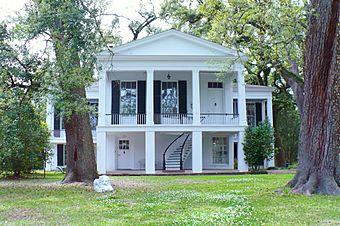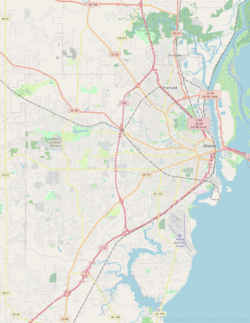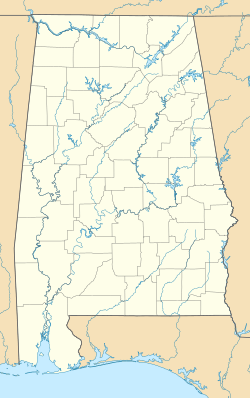Oakleigh Historic Complex (Mobile, Alabama) facts for kids
Quick facts for kids |
|
|
Oakleigh
|
|

Oakleigh, centerpiece of the Oakleigh Historic Complex
|
|
| Location | 350 Oakleigh Place Mobile, Alabama |
|---|---|
| Area | 2 acres (0.81 ha) |
| Built | 1833 |
| Architectural style | Greek Revival |
| NRHP reference No. | 71000104 |
| Added to NRHP | May 27, 1971 |
Oakleigh is a beautiful old house in Mobile, Alabama, United States, built around 1833. Today, it's a historic house museum where you can learn about life in the past. It's the main building of the Oakleigh Historic Complex. This complex includes other interesting buildings like a small house where working families lived, a building called the Union Barracks, and a modern place for old documents.
The name "Oakleigh" comes from combining "oak" (like the tree) and "lea." "Lea" is an old word from the Anglo-Saxon times that means "meadow" or "open field." The whole area around the house, called the Oakleigh Garden Historic District, is named after this historic estate.
Contents
Exploring Oakleigh's History
Oakleigh was built on about 33 acres of land west of Mobile in 1833. The person who built it was James W. Roper. He was a brick mason, which means he worked with bricks, and also a merchant who sold goods and traded cotton. He chose this spot because it had valuable clay, which was great for making bricks. He even had a brickyard in downtown Mobile.
Early Life and Challenges
While James Roper was building Oakleigh, he faced some sad times. He lost his first wife, Sarah Ann Davenport, and one of his children. In 1838, after Oakleigh was finished, he married his second wife, Eliza Ann Simison. They had four children together.
However, James Roper's business ran into trouble because of a big economic downturn called the Panic of 1837. He had borrowed a lot of money to build the house, but he couldn't pay it back. So, the bank took over the house. In 1840, James Roper and his family left Mobile and moved to New Orleans, Louisiana, where he became a lumber merchant. The bank then sold off most of the land and rented out the house.
A New Family and the Civil War
In 1852, a man named Alfred Irwin bought Oakleigh. He was the treasurer for a railroad company. During the American Civil War, his wife, Margaret Kilshaw Irwin, showed great bravery. She protected their home from Union soldiers by saying that because she was a British citizen, their property was neutral. She even hung the Union Jack flag from the balcony!
Alfred and Margaret's sons, T.K. and Lee Fearn Irwin, both fought in the Civil War. After the war, they became well-known in Mobile. Lee worked as Mobile's assistant postmaster and managed cotton and oil mills. His older brother, T.K., had even been an aide to the Confederate president, Jefferson Davis. T.K. later helped start the Mobile Cotton Exchange and became its president. Many of the letters between T.K. and his wife, Mary Anna Ketchum, from the Civil War era are still kept at Oakleigh today. The Irwin family owned Oakleigh until 1916.
Oakleigh's Unique Design
Oakleigh is built in the Greek Revival style, which was popular for grand homes. It's known as a "raised, galleried villa." This means the main living area is on the second floor, and it has a porch (gallery) all around it. Oakleigh is one of the largest T-shaped homes in Alabama. This special shape helps air flow through the house, which is perfect for Mobile's warm and humid climate.
The lower floor was originally a raised basement. It was probably built with bricks made right there on the property. This area was used for work and storage. The main living spaces, like bedrooms and parlors, were on the second floor. The unique staircase leading up to the front door was designed by James Roper himself.
The Oakleigh Historic Complex
The Oakleigh Historic Complex isn't just the main house! It also includes other buildings that help tell the story of Mobile's past. You can explore these buildings with a guided tour from friendly "Oakleigh Belles" or other guides.
- The Union Barracks: This building was built in 1867 and was once called the Cook's House. It has been restored to show what life was like for people in Mobile after the Civil War, during a time called Reconstruction. It's one of the few buildings from that period that still stands today.
- The Cox-Deasy Cottage: Built in 1850, this is a "Creole raised cottage." It's now used for programs by the Historic Mobile Preservation Society, which helps protect old buildings.
- Minnie Mitchell Archives: This building holds a huge collection of historical items for the Historic Mobile Preservation Society. You can find old maps, family records, items related to Mardi Gras, old newspapers, scrapbooks, and many other special collections here.




